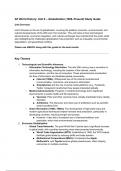AP World History: Unit 9 – Globalization (1900–Present) Study Guide
Unit Overview:
Unit 9 focuses on the era of globalization, covering the political, economic, environmental, and
cultural developments of the 20th and 21st centuries. This unit looks at how technological
advancements, economic integration, and cultural exchanges have transformed the world, while
also highlighting the challenges globalization has presented, such as inequality, environmental
degradation, and geopolitical conflicts.
Please use AMSCO along with this guide for the best results
Key Themes
1. Technological and Scientific Advances:
○ Information Technology Revolution: The late 20th century saw a revolution in
information technology, including the creation of the internet, mobile
communications, and the rise of computers. These advancements accelerated
the flow of information and facilitated global connectivity.
■ Internet (1990s): Widespread use of the internet revolutionized
communication, commerce, and access to information.
■ Smartphones and the rise of social media platforms (e.g., Facebook,
Twitter, Instagram) transformed how people interacted globally.
○ Medical Advancements: Progress in medical technology led to significant
improvements in public health and life expectancy.
■ Vaccines: Polio and other vaccines have virtually eradicated many deadly
diseases.
■ Antibiotics: The discovery and mass use of antibiotics such as penicillin
saved countless lives.
○ Green Revolution (1950s–1960s): The development of high-yield crops and
modern agricultural techniques helped increase food production, particularly in
developing countries, reducing hunger and poverty.
■ However, it also led to increased use of chemical fertilizers and
pesticides, which had environmental consequences.
2. Economic Globalization:
○ Global Trade Networks: The post-World War II period saw a significant increase
in global trade, with countries becoming more interconnected economically.
■ World Trade Organization (WTO): Established in 1995, the WTO helped
facilitate global trade by reducing tariffs and trade barriers.
■ Multinational Corporations (MNCs): Companies like Apple,
McDonald's, and Toyota became global powerhouses, often shaping
economies in multiple countries.
, ■ Offshoring and Outsourcing: Many companies moved production to
countries with cheaper labor, creating a more interconnected global
workforce.
○ Economic Integration:
■ European Union (EU): Created a single market among member nations,
allowing for the free movement of goods, services, and people across
European borders.
■ NAFTA (North American Free Trade Agreement): Facilitated trade
between the U.S., Canada, and Mexico, reducing tariffs and boosting
cross-border commerce.
○ Rise of Emerging Markets:
■ Countries like China, India, and Brazil became major players in the
global economy. China, in particular, emerged as a global manufacturing
hub.
■ The BRICS nations (Brazil, Russia, India, China, and South Africa)
gained influence in global economics and politics.
○ Global Financial Crises:
■ The 2008 Financial Crisis was a major economic downturn triggered by
the collapse of housing markets in the U.S. and the failure of major
financial institutions. It had worldwide effects and highlighted the
interconnected nature of the global economy.
3. Cultural Globalization:
○ Cultural Exchange: Globalization allowed for the rapid exchange of cultural
practices, leading to the spread of food, music, films, and other aspects of culture
around the world.
■ Examples include the global popularity of American fast food, Japanese
anime, Bollywood films, and K-pop.
○ Cultural Homogenization vs. Cultural Hybridization:
■ Globalization often leads to cultural homogenization, where dominant
cultures influence or replace local traditions (e.g., the spread of Western
fashion and fast food).
■ However, it can also lead to cultural hybridization, where cultures blend,
creating new, unique cultural expressions.
○ Migration: Increased migration resulted in the spread of cultures across borders,
contributing to multicultural societies but also sparking debates over immigration,
national identity, and cultural integration.
4. Social Movements and Human Rights:
○ Feminist Movements: From the 20th century onwards, global movements
advocated for women’s rights, including the right to vote, equal pay, reproductive
rights, and access to education.
■ In many countries, feminist movements led to greater gender equality in
politics, the workplace, and education.
○ Civil Rights Movements:




